Construction Information: Evaluating Diverse Project Types and Details
VerifiedAdded on 2023/01/13
|8
|1535
|91
Report
AI Summary
This report provides a comprehensive overview of construction information, focusing on drawings, details, and specifications within the context of a five-story building project near Heathrow Airport. The report evaluates different types of construction information, including conceptual design, schematic design, presentation information, and working drawings. It examines the roles of various construction professionals, such as architects, electrical engineers, mechanical engineers, and structural engineers, in the production and interpretation of construction information. The report emphasizes the importance of collaboration and the use of tools like CAD and BIM in facilitating effective communication and project coordination. It includes a schedule of works, details on door and window schedules, and a section detail of an external drainage system. The report highlights the significance of construction documents, working drawings, and specifications in ensuring project success and compliance with building codes. The report also emphasizes the importance of BIM in streamlining the design process and improving information accessibility for all stakeholders, ensuring that the project meets the client's requirements and avoids potential errors and delays.
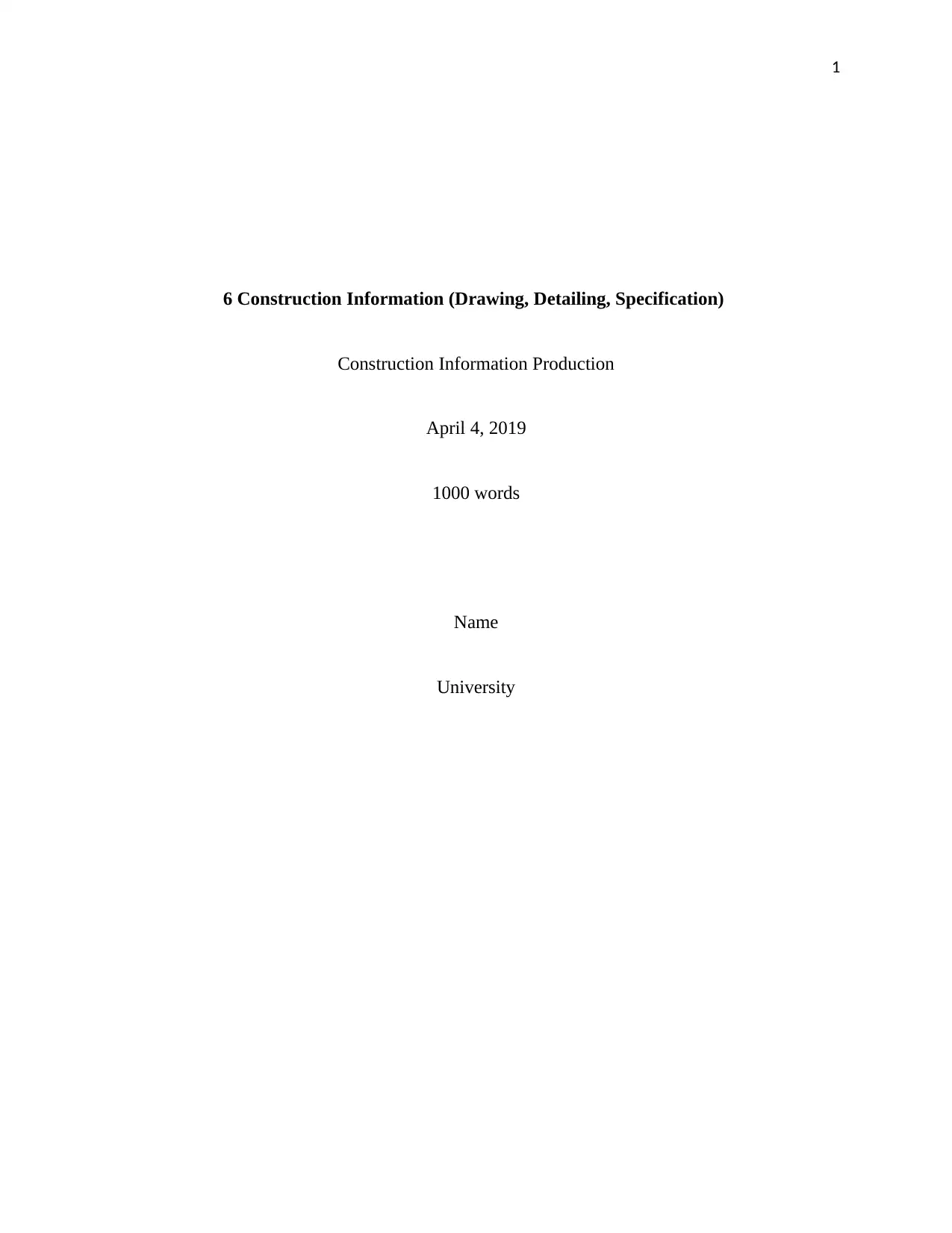
1
6 Construction Information (Drawing, Detailing, Specification)
Construction Information Production
April 4, 2019
1000 words
Name
University
6 Construction Information (Drawing, Detailing, Specification)
Construction Information Production
April 4, 2019
1000 words
Name
University
Paraphrase This Document
Need a fresh take? Get an instant paraphrase of this document with our AI Paraphraser
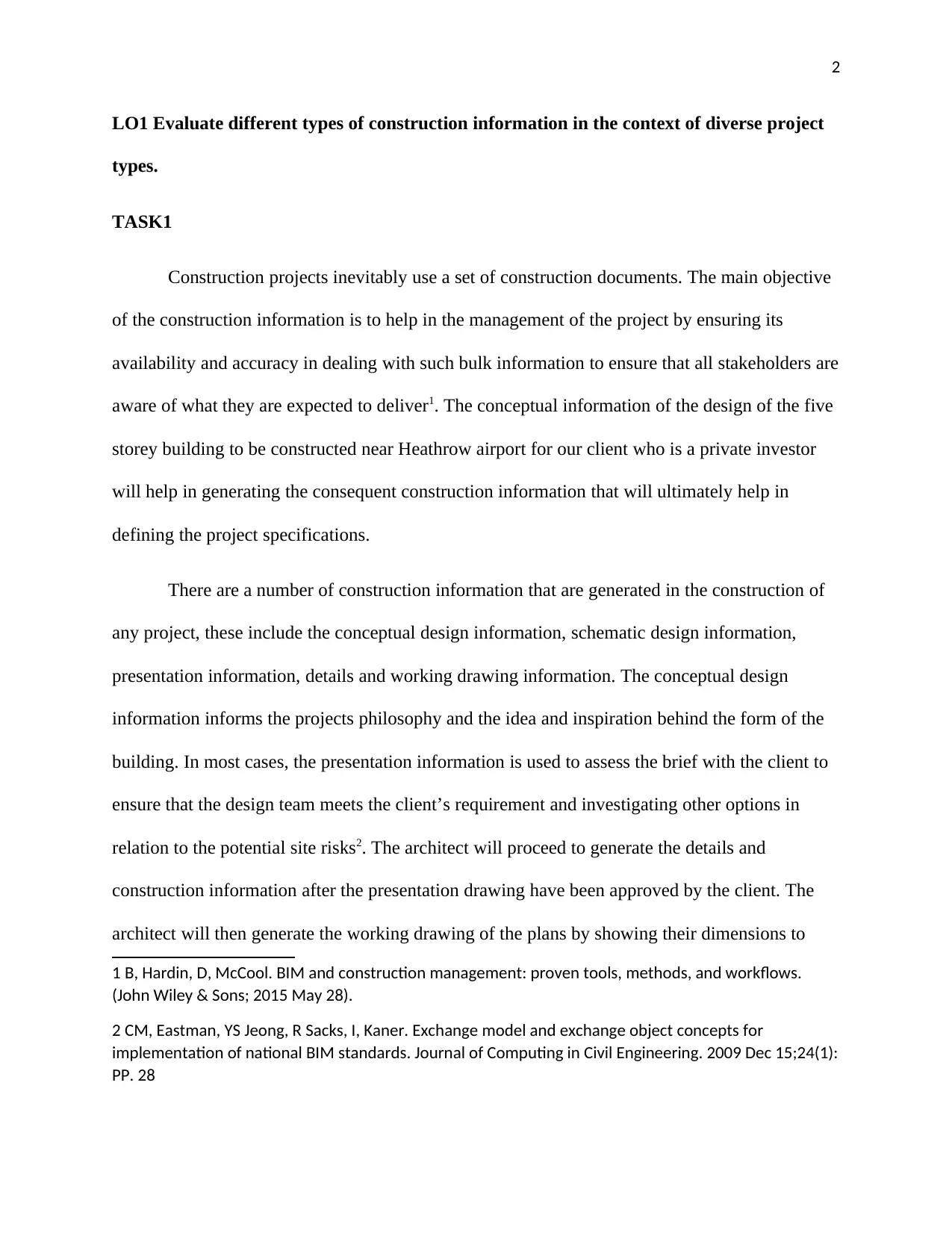
2
LO1 Evaluate different types of construction information in the context of diverse project
types.
TASK1
Construction projects inevitably use a set of construction documents. The main objective
of the construction information is to help in the management of the project by ensuring its
availability and accuracy in dealing with such bulk information to ensure that all stakeholders are
aware of what they are expected to deliver1. The conceptual information of the design of the five
storey building to be constructed near Heathrow airport for our client who is a private investor
will help in generating the consequent construction information that will ultimately help in
defining the project specifications.
There are a number of construction information that are generated in the construction of
any project, these include the conceptual design information, schematic design information,
presentation information, details and working drawing information. The conceptual design
information informs the projects philosophy and the idea and inspiration behind the form of the
building. In most cases, the presentation information is used to assess the brief with the client to
ensure that the design team meets the client’s requirement and investigating other options in
relation to the potential site risks2. The architect will proceed to generate the details and
construction information after the presentation drawing have been approved by the client. The
architect will then generate the working drawing of the plans by showing their dimensions to
1 B, Hardin, D, McCool. BIM and construction management: proven tools, methods, and workflows.
(John Wiley & Sons; 2015 May 28).
2 CM, Eastman, YS Jeong, R Sacks, I, Kaner. Exchange model and exchange object concepts for
implementation of national BIM standards. Journal of Computing in Civil Engineering. 2009 Dec 15;24(1):
PP. 28
LO1 Evaluate different types of construction information in the context of diverse project
types.
TASK1
Construction projects inevitably use a set of construction documents. The main objective
of the construction information is to help in the management of the project by ensuring its
availability and accuracy in dealing with such bulk information to ensure that all stakeholders are
aware of what they are expected to deliver1. The conceptual information of the design of the five
storey building to be constructed near Heathrow airport for our client who is a private investor
will help in generating the consequent construction information that will ultimately help in
defining the project specifications.
There are a number of construction information that are generated in the construction of
any project, these include the conceptual design information, schematic design information,
presentation information, details and working drawing information. The conceptual design
information informs the projects philosophy and the idea and inspiration behind the form of the
building. In most cases, the presentation information is used to assess the brief with the client to
ensure that the design team meets the client’s requirement and investigating other options in
relation to the potential site risks2. The architect will proceed to generate the details and
construction information after the presentation drawing have been approved by the client. The
architect will then generate the working drawing of the plans by showing their dimensions to
1 B, Hardin, D, McCool. BIM and construction management: proven tools, methods, and workflows.
(John Wiley & Sons; 2015 May 28).
2 CM, Eastman, YS Jeong, R Sacks, I, Kaner. Exchange model and exchange object concepts for
implementation of national BIM standards. Journal of Computing in Civil Engineering. 2009 Dec 15;24(1):
PP. 28
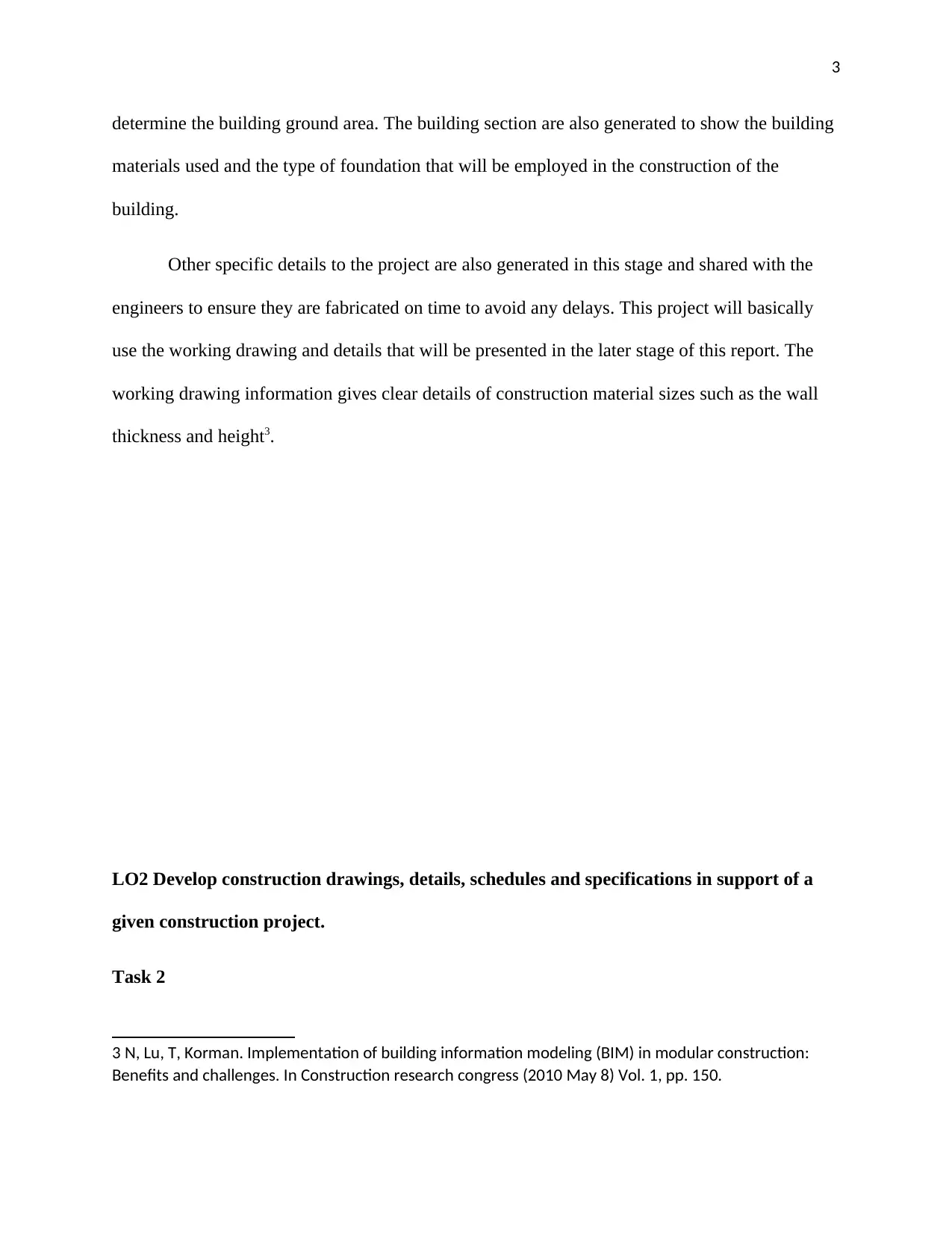
3
determine the building ground area. The building section are also generated to show the building
materials used and the type of foundation that will be employed in the construction of the
building.
Other specific details to the project are also generated in this stage and shared with the
engineers to ensure they are fabricated on time to avoid any delays. This project will basically
use the working drawing and details that will be presented in the later stage of this report. The
working drawing information gives clear details of construction material sizes such as the wall
thickness and height3.
LO2 Develop construction drawings, details, schedules and specifications in support of a
given construction project.
Task 2
3 N, Lu, T, Korman. Implementation of building information modeling (BIM) in modular construction:
Benefits and challenges. In Construction research congress (2010 May 8) Vol. 1, pp. 150.
determine the building ground area. The building section are also generated to show the building
materials used and the type of foundation that will be employed in the construction of the
building.
Other specific details to the project are also generated in this stage and shared with the
engineers to ensure they are fabricated on time to avoid any delays. This project will basically
use the working drawing and details that will be presented in the later stage of this report. The
working drawing information gives clear details of construction material sizes such as the wall
thickness and height3.
LO2 Develop construction drawings, details, schedules and specifications in support of a
given construction project.
Task 2
3 N, Lu, T, Korman. Implementation of building information modeling (BIM) in modular construction:
Benefits and challenges. In Construction research congress (2010 May 8) Vol. 1, pp. 150.
⊘ This is a preview!⊘
Do you want full access?
Subscribe today to unlock all pages.

Trusted by 1+ million students worldwide
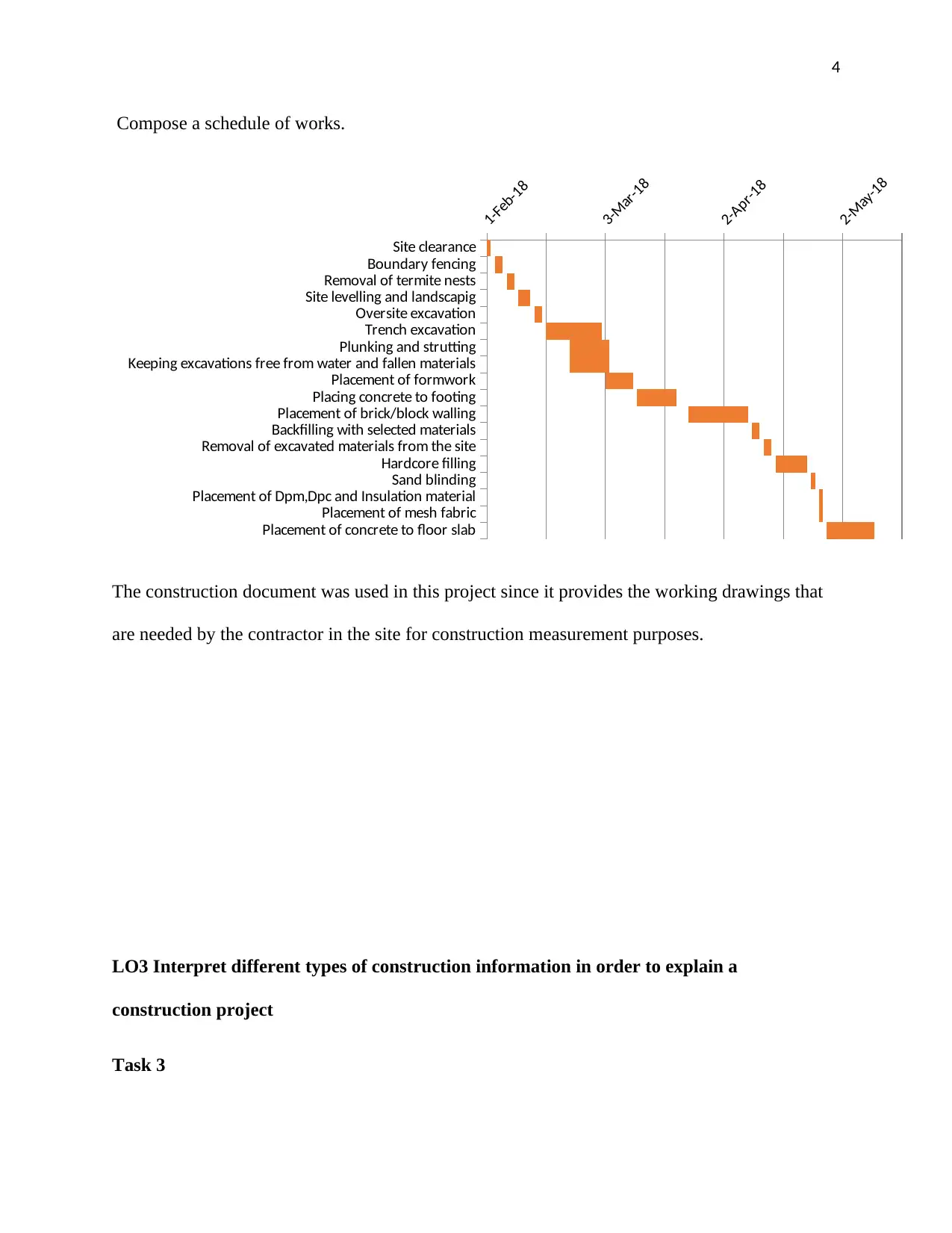
4
Compose a schedule of works.
Site clearance
Boundary fencing
Removal of termite nests
Site levelling and landscapig
Oversite excavation
Trench excavation
Plunking and strutting
Keeping excavations free from water and fallen materials
Placement of formwork
Placing concrete to footing
Placement of brick/block walling
Backfilling with selected materials
Removal of excavated materials from the site
Hardcore filling
Sand blinding
Placement of Dpm,Dpc and Insulation material
Placement of mesh fabric
Placement of concrete to floor slab
1-Feb-18
3-Mar-18
2-Apr-18
2-May-18
The construction document was used in this project since it provides the working drawings that
are needed by the contractor in the site for construction measurement purposes.
LO3 Interpret different types of construction information in order to explain a
construction project
Task 3
Compose a schedule of works.
Site clearance
Boundary fencing
Removal of termite nests
Site levelling and landscapig
Oversite excavation
Trench excavation
Plunking and strutting
Keeping excavations free from water and fallen materials
Placement of formwork
Placing concrete to footing
Placement of brick/block walling
Backfilling with selected materials
Removal of excavated materials from the site
Hardcore filling
Sand blinding
Placement of Dpm,Dpc and Insulation material
Placement of mesh fabric
Placement of concrete to floor slab
1-Feb-18
3-Mar-18
2-Apr-18
2-May-18
The construction document was used in this project since it provides the working drawings that
are needed by the contractor in the site for construction measurement purposes.
LO3 Interpret different types of construction information in order to explain a
construction project
Task 3
Paraphrase This Document
Need a fresh take? Get an instant paraphrase of this document with our AI Paraphraser
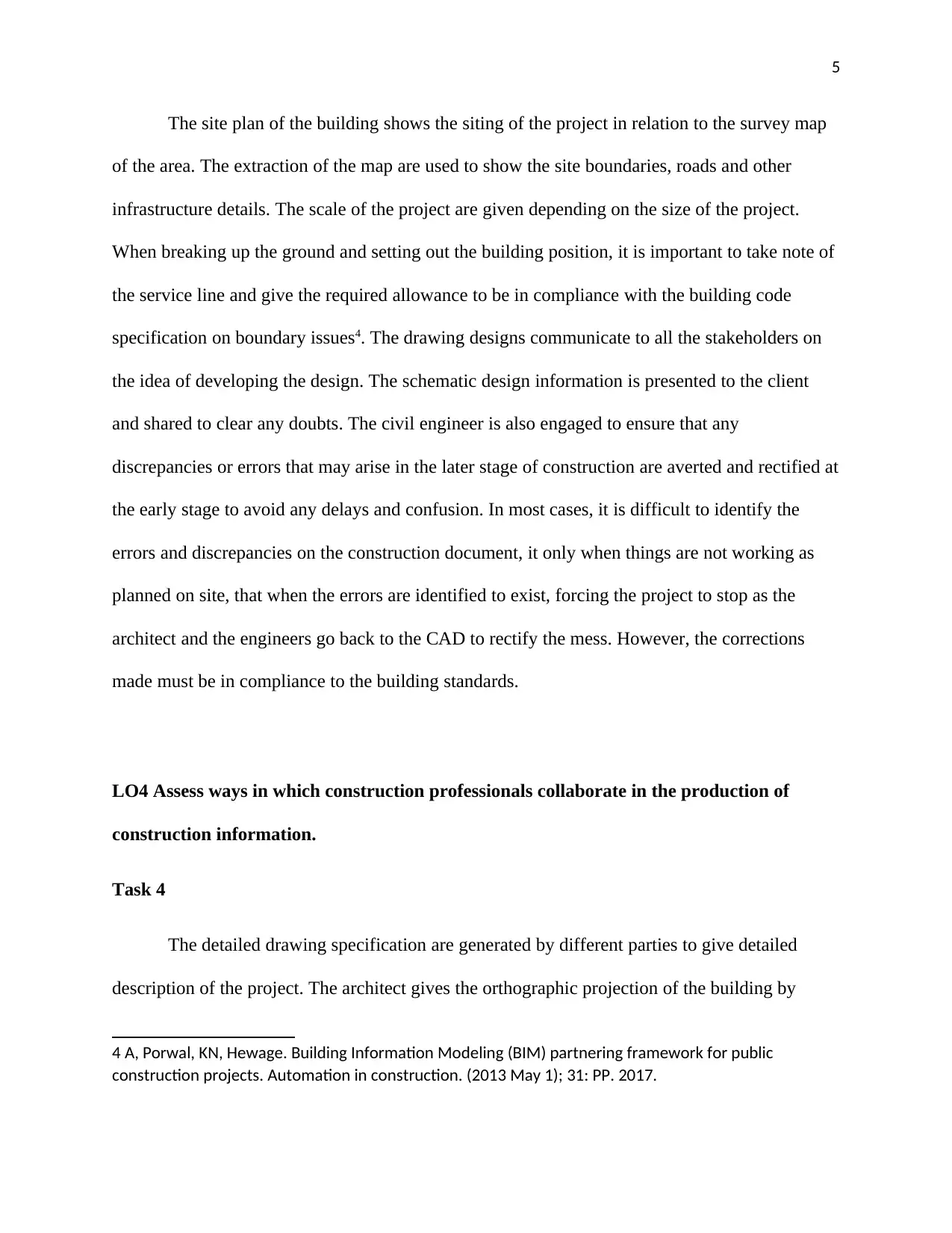
5
The site plan of the building shows the siting of the project in relation to the survey map
of the area. The extraction of the map are used to show the site boundaries, roads and other
infrastructure details. The scale of the project are given depending on the size of the project.
When breaking up the ground and setting out the building position, it is important to take note of
the service line and give the required allowance to be in compliance with the building code
specification on boundary issues4. The drawing designs communicate to all the stakeholders on
the idea of developing the design. The schematic design information is presented to the client
and shared to clear any doubts. The civil engineer is also engaged to ensure that any
discrepancies or errors that may arise in the later stage of construction are averted and rectified at
the early stage to avoid any delays and confusion. In most cases, it is difficult to identify the
errors and discrepancies on the construction document, it only when things are not working as
planned on site, that when the errors are identified to exist, forcing the project to stop as the
architect and the engineers go back to the CAD to rectify the mess. However, the corrections
made must be in compliance to the building standards.
LO4 Assess ways in which construction professionals collaborate in the production of
construction information.
Task 4
The detailed drawing specification are generated by different parties to give detailed
description of the project. The architect gives the orthographic projection of the building by
4 A, Porwal, KN, Hewage. Building Information Modeling (BIM) partnering framework for public
construction projects. Automation in construction. (2013 May 1); 31: PP. 2017.
The site plan of the building shows the siting of the project in relation to the survey map
of the area. The extraction of the map are used to show the site boundaries, roads and other
infrastructure details. The scale of the project are given depending on the size of the project.
When breaking up the ground and setting out the building position, it is important to take note of
the service line and give the required allowance to be in compliance with the building code
specification on boundary issues4. The drawing designs communicate to all the stakeholders on
the idea of developing the design. The schematic design information is presented to the client
and shared to clear any doubts. The civil engineer is also engaged to ensure that any
discrepancies or errors that may arise in the later stage of construction are averted and rectified at
the early stage to avoid any delays and confusion. In most cases, it is difficult to identify the
errors and discrepancies on the construction document, it only when things are not working as
planned on site, that when the errors are identified to exist, forcing the project to stop as the
architect and the engineers go back to the CAD to rectify the mess. However, the corrections
made must be in compliance to the building standards.
LO4 Assess ways in which construction professionals collaborate in the production of
construction information.
Task 4
The detailed drawing specification are generated by different parties to give detailed
description of the project. The architect gives the orthographic projection of the building by
4 A, Porwal, KN, Hewage. Building Information Modeling (BIM) partnering framework for public
construction projects. Automation in construction. (2013 May 1); 31: PP. 2017.
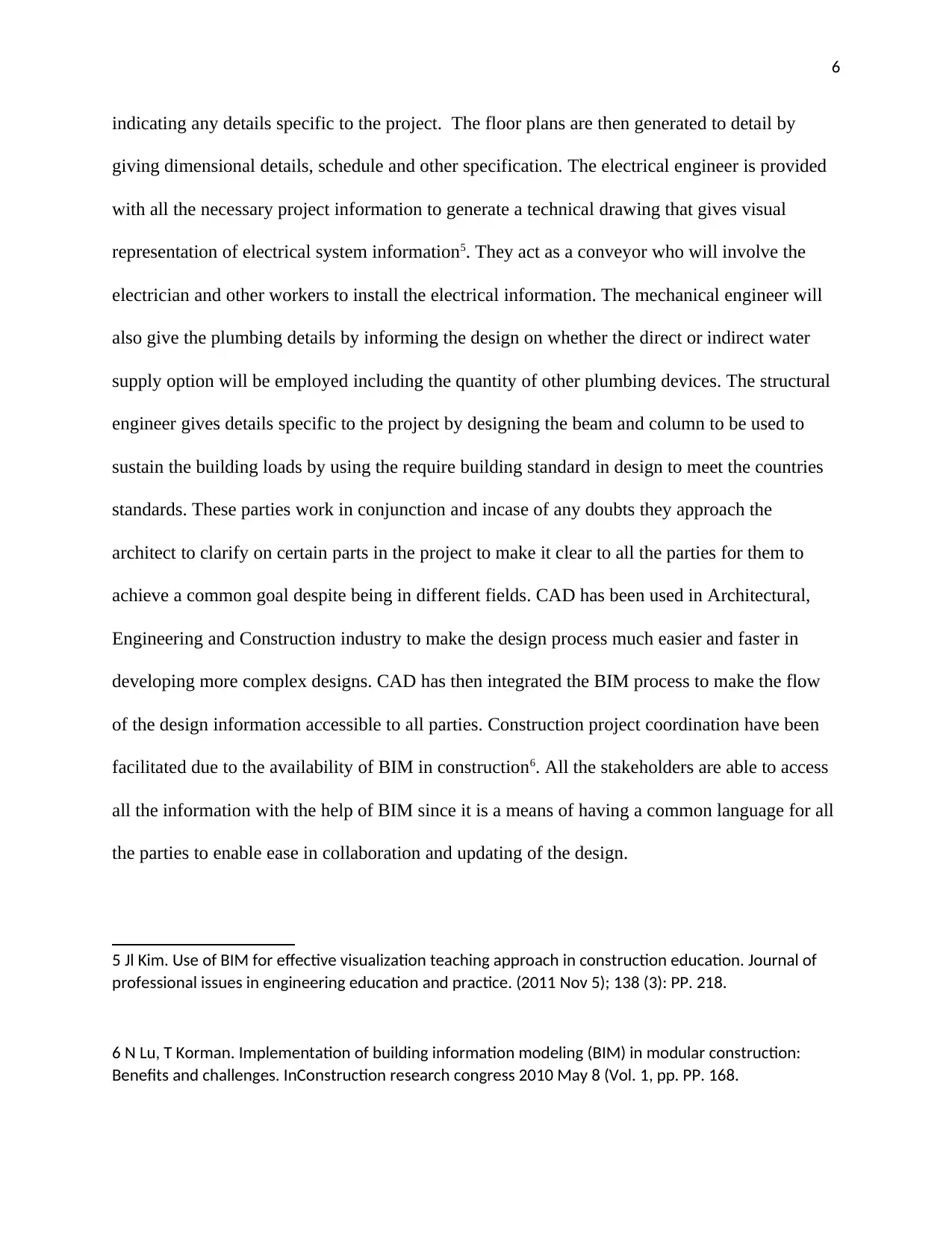
6
indicating any details specific to the project. The floor plans are then generated to detail by
giving dimensional details, schedule and other specification. The electrical engineer is provided
with all the necessary project information to generate a technical drawing that gives visual
representation of electrical system information5. They act as a conveyor who will involve the
electrician and other workers to install the electrical information. The mechanical engineer will
also give the plumbing details by informing the design on whether the direct or indirect water
supply option will be employed including the quantity of other plumbing devices. The structural
engineer gives details specific to the project by designing the beam and column to be used to
sustain the building loads by using the require building standard in design to meet the countries
standards. These parties work in conjunction and incase of any doubts they approach the
architect to clarify on certain parts in the project to make it clear to all the parties for them to
achieve a common goal despite being in different fields. CAD has been used in Architectural,
Engineering and Construction industry to make the design process much easier and faster in
developing more complex designs. CAD has then integrated the BIM process to make the flow
of the design information accessible to all parties. Construction project coordination have been
facilitated due to the availability of BIM in construction6. All the stakeholders are able to access
all the information with the help of BIM since it is a means of having a common language for all
the parties to enable ease in collaboration and updating of the design.
5 Jl Kim. Use of BIM for effective visualization teaching approach in construction education. Journal of
professional issues in engineering education and practice. (2011 Nov 5); 138 (3): PP. 218.
6 N Lu, T Korman. Implementation of building information modeling (BIM) in modular construction:
Benefits and challenges. InConstruction research congress 2010 May 8 (Vol. 1, pp. PP. 168.
indicating any details specific to the project. The floor plans are then generated to detail by
giving dimensional details, schedule and other specification. The electrical engineer is provided
with all the necessary project information to generate a technical drawing that gives visual
representation of electrical system information5. They act as a conveyor who will involve the
electrician and other workers to install the electrical information. The mechanical engineer will
also give the plumbing details by informing the design on whether the direct or indirect water
supply option will be employed including the quantity of other plumbing devices. The structural
engineer gives details specific to the project by designing the beam and column to be used to
sustain the building loads by using the require building standard in design to meet the countries
standards. These parties work in conjunction and incase of any doubts they approach the
architect to clarify on certain parts in the project to make it clear to all the parties for them to
achieve a common goal despite being in different fields. CAD has been used in Architectural,
Engineering and Construction industry to make the design process much easier and faster in
developing more complex designs. CAD has then integrated the BIM process to make the flow
of the design information accessible to all parties. Construction project coordination have been
facilitated due to the availability of BIM in construction6. All the stakeholders are able to access
all the information with the help of BIM since it is a means of having a common language for all
the parties to enable ease in collaboration and updating of the design.
5 Jl Kim. Use of BIM for effective visualization teaching approach in construction education. Journal of
professional issues in engineering education and practice. (2011 Nov 5); 138 (3): PP. 218.
6 N Lu, T Korman. Implementation of building information modeling (BIM) in modular construction:
Benefits and challenges. InConstruction research congress 2010 May 8 (Vol. 1, pp. PP. 168.
⊘ This is a preview!⊘
Do you want full access?
Subscribe today to unlock all pages.

Trusted by 1+ million students worldwide
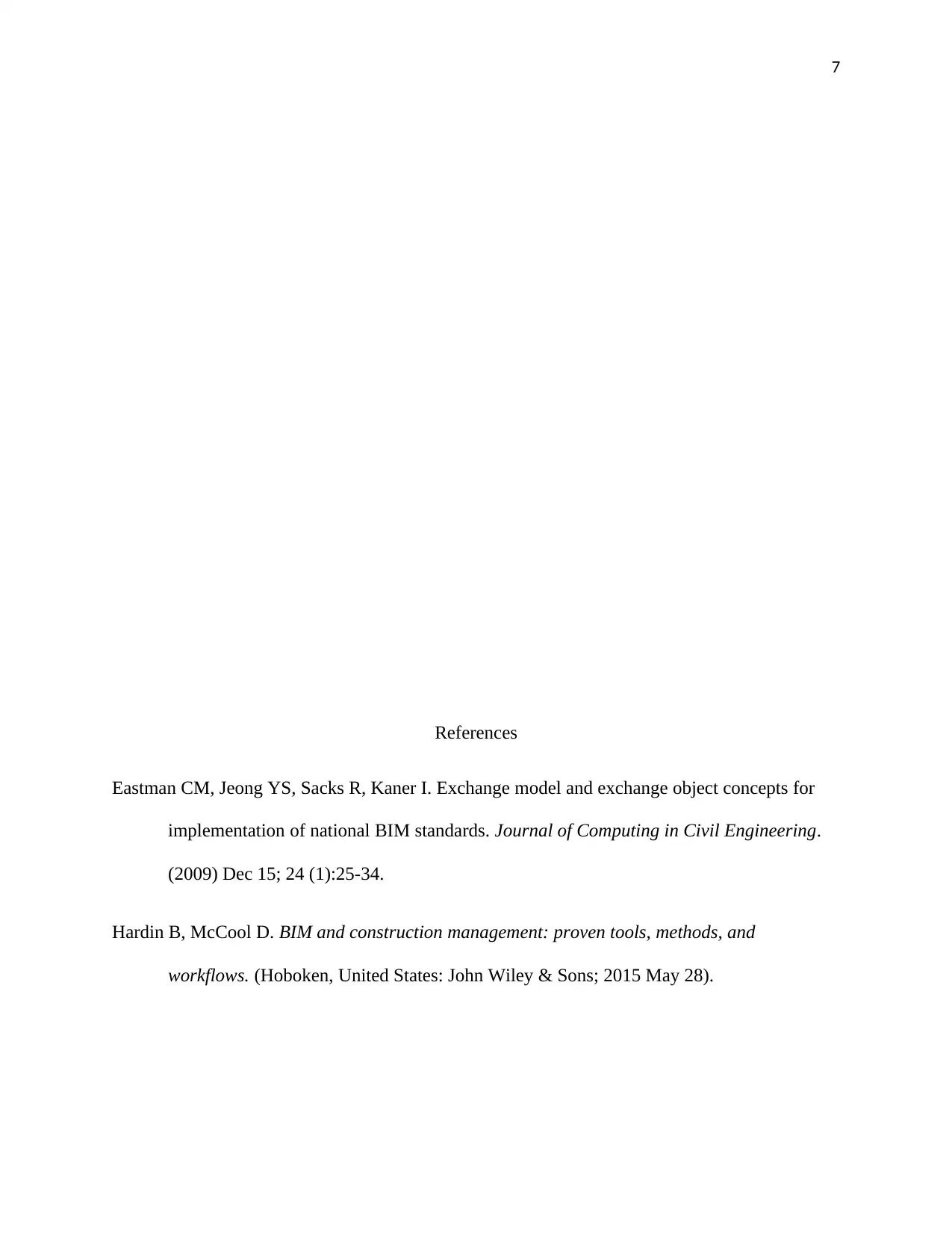
7
References
Eastman CM, Jeong YS, Sacks R, Kaner I. Exchange model and exchange object concepts for
implementation of national BIM standards. Journal of Computing in Civil Engineering.
(2009) Dec 15; 24 (1):25-34.
Hardin B, McCool D. BIM and construction management: proven tools, methods, and
workflows. (Hoboken, United States: John Wiley & Sons; 2015 May 28).
References
Eastman CM, Jeong YS, Sacks R, Kaner I. Exchange model and exchange object concepts for
implementation of national BIM standards. Journal of Computing in Civil Engineering.
(2009) Dec 15; 24 (1):25-34.
Hardin B, McCool D. BIM and construction management: proven tools, methods, and
workflows. (Hoboken, United States: John Wiley & Sons; 2015 May 28).
Paraphrase This Document
Need a fresh take? Get an instant paraphrase of this document with our AI Paraphraser
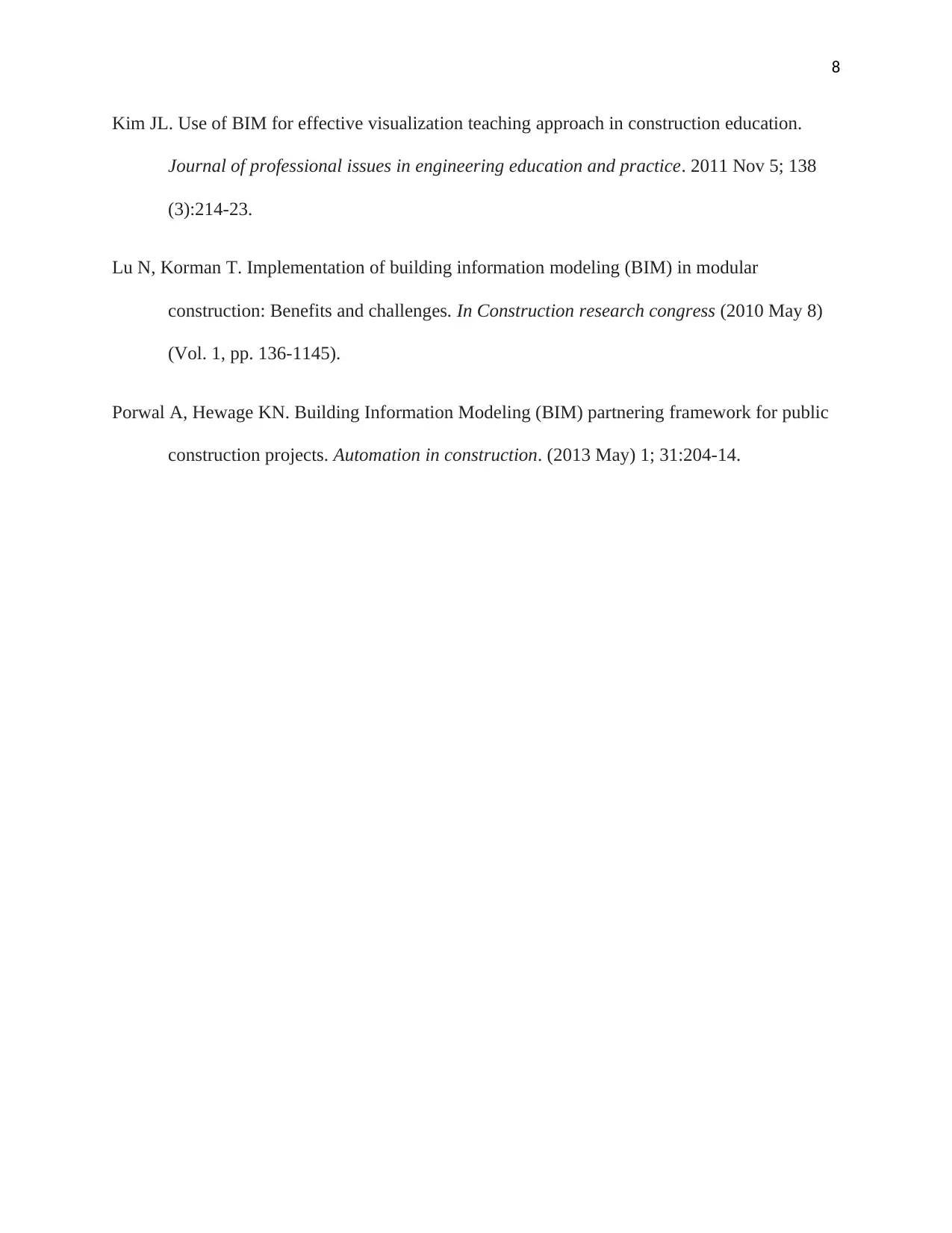
8
Kim JL. Use of BIM for effective visualization teaching approach in construction education.
Journal of professional issues in engineering education and practice. 2011 Nov 5; 138
(3):214-23.
Lu N, Korman T. Implementation of building information modeling (BIM) in modular
construction: Benefits and challenges. In Construction research congress (2010 May 8)
(Vol. 1, pp. 136-1145).
Porwal A, Hewage KN. Building Information Modeling (BIM) partnering framework for public
construction projects. Automation in construction. (2013 May) 1; 31:204-14.
Kim JL. Use of BIM for effective visualization teaching approach in construction education.
Journal of professional issues in engineering education and practice. 2011 Nov 5; 138
(3):214-23.
Lu N, Korman T. Implementation of building information modeling (BIM) in modular
construction: Benefits and challenges. In Construction research congress (2010 May 8)
(Vol. 1, pp. 136-1145).
Porwal A, Hewage KN. Building Information Modeling (BIM) partnering framework for public
construction projects. Automation in construction. (2013 May) 1; 31:204-14.
1 out of 8
Related Documents
Your All-in-One AI-Powered Toolkit for Academic Success.
+13062052269
info@desklib.com
Available 24*7 on WhatsApp / Email
![[object Object]](/_next/static/media/star-bottom.7253800d.svg)
Unlock your academic potential
Copyright © 2020–2025 A2Z Services. All Rights Reserved. Developed and managed by ZUCOL.



